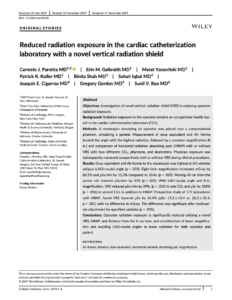Introduction
Radiation exposure in the cardiac catheterization laboratory (CCL) is known to have both stochastic and deterministic effects on the patient and the operator.1–5 Fluoroscopy-guided transcatheter interventions have become more complex over the past decade with chronic total occlusion techniques, high-risk coronary interventions, mechanical support devices, and structural interventions in a population with rising body mass index (BMI) that may increase radiation exposure.6–8 Simple methods and devices to reduce radiation include avoidance of left anterior oblique (LAO) or steep caudal or cranial angles, lower fluoroscopy frame rates, several shields, and greater distance from the X-ray tube.9–23 A variety of more expensive, although very effective systems have been developed in reducing operator radiation exposure, including the use of a suspended radiation protection system and vascular robotics.24–27 The primary aim of this study was to compare operator radiation exposure with or without a novel vertical radiation shield (VRS) using first a mannequin and a human computational phantom, followed by evaluation during clinical procedures in the CCL.

